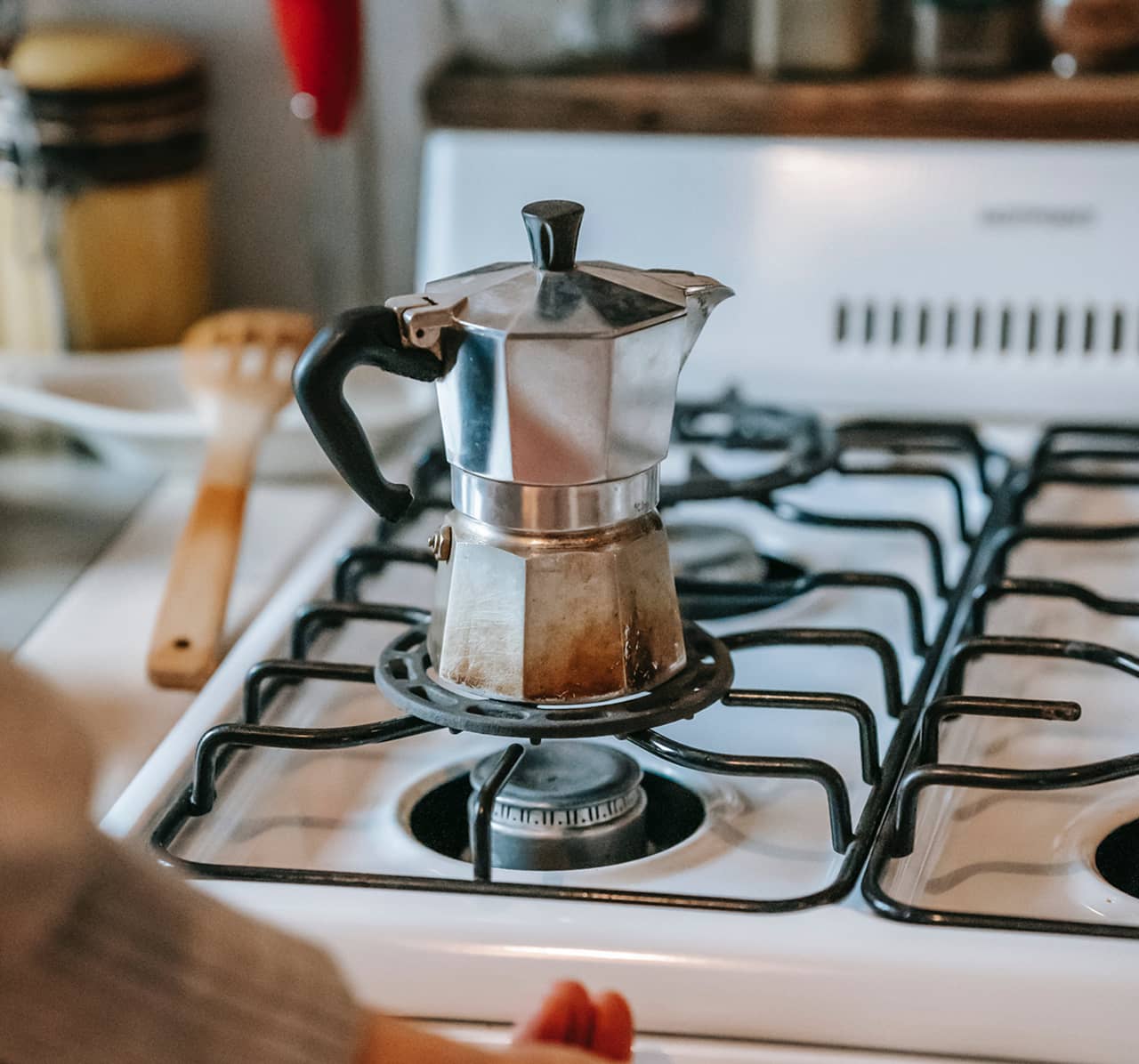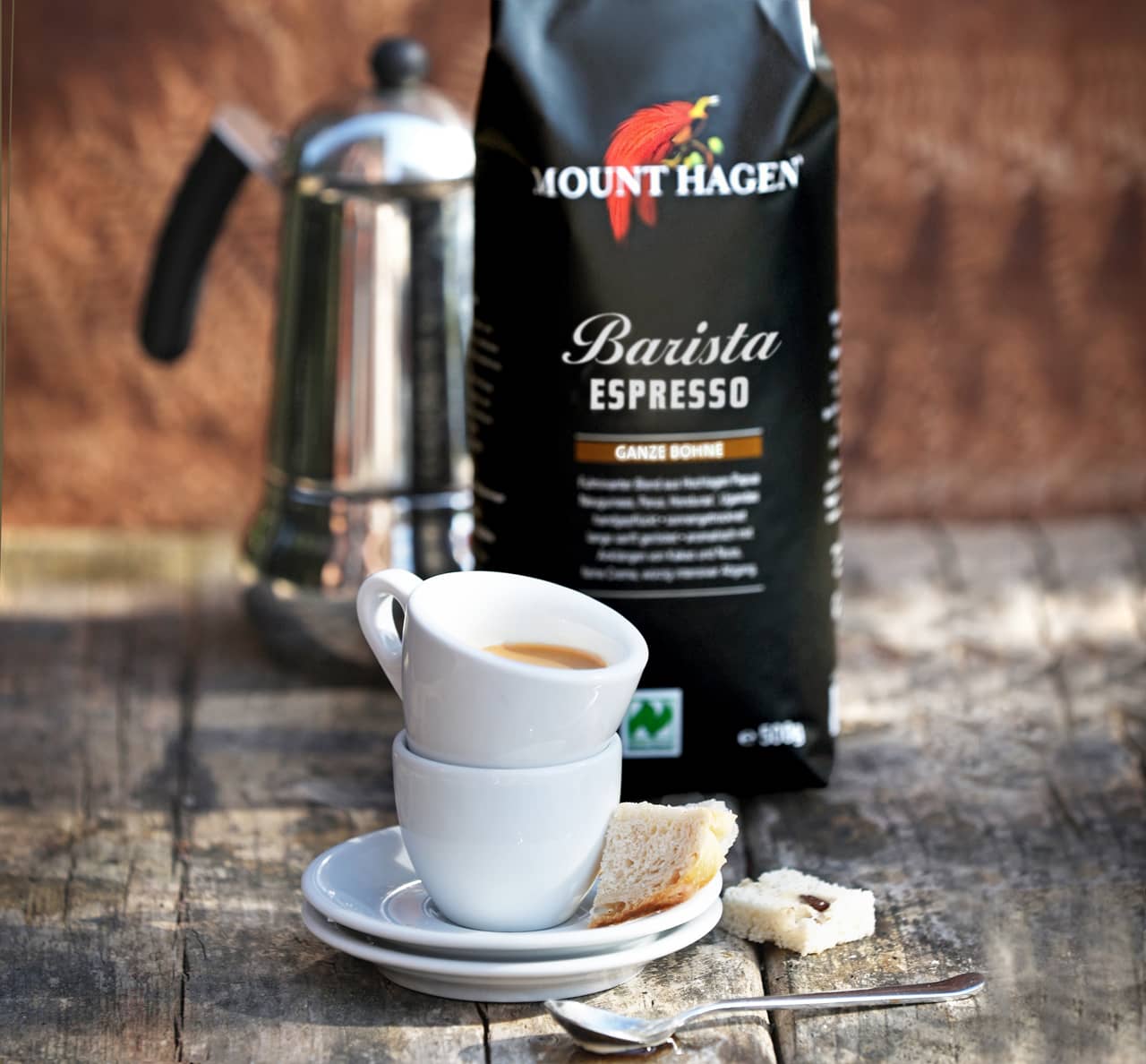- Coffee prep
The stove top coffee maker – everything you need to know about it.
It fizzes, it bubbles. It spreads a wonderful coffee aroma and produces a whole lot of Italian lifestyle in a very uncomplicated way – in addition to a very aromatic cup of coffee. The stove top coffee maker, also known as a bialetti or caffettiera or moka pot. Many names for a fairly simple little pot.

Karsten Suhr
What exactly is a stove top coffee maker?
Every coffee lover has probably seen it before: 8-sided, made of aluminum, with a black handle, it stands on the stove, hissing and bubbling, and spreading that Italian feeling. As I said, the stove top espresso or coffee maker doesn’t actually make espresso, but a very aromatic coffee. For a “real” classic espresso, you need a brewing pressure of approx. 9 bar. The coffee maker only reaches a brewing pressure of 2 bar. However, this is really no reduction in quality, as the result is an extremely tasty, intense cup – just more coffee than espresso.
A brief look at the history of the stove top coffee maker.
Although the coffee maker was invented by Otello Amletto Spadin, Alfonso Bialetti, a foundryman by trade, produced the so-called “Triplerapid Miracol 900” as early as 1937. It became world-famous as the “Moka Express” or Bialetti after the Second World War thanks to Alfonso’s son, Renato Bialetti, who marketed the octagonal pot under the motto “in casa un espresso come al bar” (at home an espresso like in a café). And it was hugely successful. Today, it is impossible to imagine a coffee-loving household without the Bialetti, an absolute classic.
Espresso vs. coffee maker coffee
The main differences are not just in taste:
1. The crema. A stove top coffee maker produces little or no crema, whereas a portafilter (due to the high pressure) produces a beautiful golden, so-called tiger stripe crema, which is also a sign of quality for a perfectly prepared espresso. You can read more about that here: “Tiger-stripe crema.”. The coffee from the coffee maker is more similar to drip coffee in terms of preparation, although it tastes stronger, more intense, and slightly “thicker” than a pour-over coffee.
2. The size. A coffee maker is small, handy and light. You can take it with you when traveling, e.g. camping or hiking. You don’t need more than a simple camping stove to brew a very tasty coffee.
3. The cost: A good espresso machine can easily cost 2,000 dollars. The coffee maker, on the other hand, is available for around 20 dollars, depending on the size/cup quantity.
How the coffee maker works.
The stove top pot always consists of 3 parts: The lower water container, the strainer insert, and the upper jug. When the coffee maker is placed on the stove, the water in the lower part heats up, generating steam, which increases the pressure, and the water is forced upwards through the coffee grounds. The extracted coffee flows into the upper jug. The valve on the lower water container relieves the excess pressure, hot steam hisses out here during boiling, you should be careful not to burn yourself.
The perfect coffee from the coffee maker. This is how it works.
Fill the lower water tank with hot water (this saves a lot of energy). Attention, the water level must leave the valve free! Then pour the freshly ground coffee into the sieve (grind: between very fine for the portafilter and coarse for the French press). And here too, be careful not to add more than the rim mark! And only smooth or tap. Do NOT press firmly, otherwise the coffee will be bitter.
Incidentally, the Italian “Moka Master” recommends 0,4oz of coffee per 3.4 f oz of water. But this is also a question of taste and depends a little on the coffee. Some baristas use coffee, but I personally prefer espresso roasts for the stove top coffee maker.
Then screw on the upper jug container, close tightly and place the coffee maker on the stove top.
Caution: The aluminum jugs do not work on induction stoves, you need a stainless steel jug.
When the coffee hisses and bubbles, turn off the heat and the coffee is ready. If the coffee tastes too bitter, reduce the heat next time and take the pot off the stove earlier.
foto:
gary barnes from pexels

About the material, models and design of coffee makers.
Even though there have been and still are new coffee maker models over the years, the principle and the main differences remain the same.
1. The material: The classic from Bialetti is made of aluminum. The advantage: Aluminum conducts heat extremely well. Stainless steel, for example, has only one 20th of this conductivity. One small but: Aluminum coffee makers are not suitable for induction stoves. However, there are models that are made of stainless steel or have a double base with stainless steel.
Advantages: Aluminum is cheap and light, so the pots are available for around €20. Incidentally, you don’t need to worry about aluminum residues in the coffee, because the patina (oxide layer that forms during cooking) forms a protective layer, according to the Institute for Risk Assessment (BfR). It carried out random sample analyses with brand new mocha pots in 2017.
Disadvantage: Aluminum coffee makers must not be put in the dishwasher. You should also be careful with washing-up liquid and sponges. It is best to use hot water or vinegar water.
Stainless steel coffee makers are the modern version of the aluminum teapot, so to speak. Stainless steel is robust, tasteless, scratch-resistant, looks pretty nice, but is relatively heavy. Some models have a lever lock, which makes opening and closing a little easier. Due to the material, stainless steel coffee makers are more expensive than the aluminum version. There are now also stove top pots whose top is made of ceramic or earthenware – I think it’s a question of personal taste. The finish and the handle are important. The pot itself gets extremely hot, so the handle must be well insulated.
2. Heating: Classic coffee makers are simply placed on the stove, be it gas or ceramic or a camping stove or campfire. Induction stoves need stainless steel. You can test whether your coffee maker is suitable for this with a magnet. If it sticks to the base of the pot, then you can use the stove on the induction hob (ferromagnetic steel base – also applies to cooking pots, by the way).
There are also electric coffee makers where the heat source is integrated. You do need electricity. However, the automatic switch-off function makes it very convenient.
Finding the right coffee maker? It's easy.
The first question you should ask yourself: Electricity or stove? The electric version is of course more expensive, you can expect to pay around $50 upwards. If you have the space in your kitchen or camper van, it’s a very convenient option, similar to a coffee machine – but without the paper filter.
If you decide on the stove variant, the next question is: Which stove? This is crucial for the choice of material. For ceramic hobs and gas stoves, you can use the cheaper aluminum espresso pots. For induction hobs, you need the stainless-steel version of the coffee maker (which will also work on ceramic and gas hobs).
That leaves the size of the coffee maker: Most people actually have several sizes in their household – from the very small one (1-2 cups) for a quick, small coffee in between to the large one for 8-10 cups. As the coffee from the stove top pot tastes best when you use the pot to the full, it makes perfect sense to have several sizes to choose from.
And then? Then comes your personal style, your aesthetic. Do you prefer brushed stainless steel or a high-gloss finish? Do you like authentic classics? Or modern design?
foto:
michael bernhardi

What's different about coffee from a coffee maker? A comparison.
- Drip coffee or pour-over coffee – whether brewed in a coffee machine, hand filter, Chemex or Aeropress – is always a somewhat cleaner, lighter, sometimes fruity, fresh coffee. Quite simply because more oils are filtered out of the ground coffee. Of course, the type of coffee (we love our classic Arabica coffee in a medium roast) and the type of filter also make a difference here. Our “Filter facts.” will enlighten you further.
- The espresso from the portafilter is of course not a coffee, but an espresso. This means not only a different roasting of the beans, but also much more coffee oils, much more concentration – it is much thicker in the small cup. You can find out how to make the perfect espresso with your own portafilter machine – for example the right grind, right quantity, right brewing temperature, etc. – here: “How to set your portafilter correctly”.
- The French press. This brews what is known as a full-immersion coffee. This means that the coffee comes into complete contact with water (unlike drip coffee). This coffee is “full bodied” and has a slightly more bitter aroma. The advantages: You don’t need filter paper. You can reuse the coffee grounds – in the garden or as a scrub, etc. And you only need hot water, nothing else. We have compiled all the details about the French press, which, as the name suggests, is a classic from France, as well as all the tips and tricks here: “Aromatic, strong, and quite simple: French press coffee“.
And finally, our coffee from the coffee maker. It is an Italian institution, the classic par excellence. Due to its brewing method (see above), it ranks somewhere between drip coffee and espresso. This means: Slightly clearer, not as thick as an espresso, but stronger, and more full-bodied than a drip coffee.
If you want an overview of the main ways to make coffee – their benefits, their flavor profiles – then check out this blog post: “What is the best way to make coffee?”.
Things you should never do with the coffee maker - the most common mistakes.
Not everyone is a barista, not everyone is as crazy about coffee as we are. And not everyone has the time to try out what tastes good, what works – and what doesn’t. So, here’s a quick overview of the dos and don’ts when using the coffee maker:
1. Too much ground coffee pressed into the sieve. The coffee maker is not a portafilter. So please never tamp the coffee grounds or press them right up to the edge of the sieve – the coffee will then become bitter. There is a mark in the sieve. This is always correct if you fill the amount of water up to the mark (below the pressure relief valve). Coffee from a coffee maker always tastes best if you make optimum use of the size of the pot. So don’t do half pots.
2. Too few coffee grounds in the sieve. See above. The coffee becomes sticky.
3. Wrong grinding level. A fine grind that lies between the very fine grind of an espresso and the coarser grind for the French press is ideal. If you are using already ground espresso (or coffee), it should be “medium-fine”. If you grind your beans fresh, which we always recommend, then you can of course experiment a little.
4. Overheating of the coffee maker. If you set the stove too hot or leave the pot on it for too long, the coffee will “burn”. It stinks. And the taste is aweful. It’s best to use hot water for the bottom container, this saves energy (and time) and the coffee can’t burn. If the coffee is too bitter, you have either pressed the grounds or the temperature was too high. And another tip: Always close the lid of the jug, otherwise you’ll end up with wild splashing, including coffee stains on the wall – and, if you’re unlucky, even scalding.
This sounds as if the stove top coffee maker aka Bialetti aka moka pot is a hell of a machine – but it’s not. It is a godsend for anyone who loves Italian-style, very aromatic coffee. It is very easy to use. And it’s even “sustainable” because you don’t need any other accessories to make this outrageously delicious coffee. What more could you ask for?



